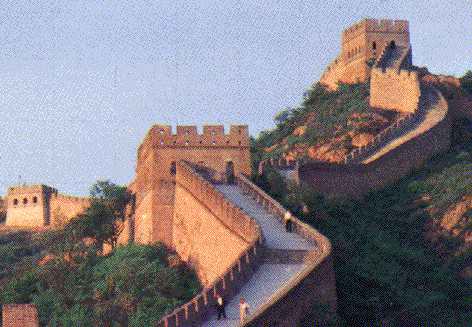
Overview of Shanxi
Shanxi is a province in the northern part of the People’s Republic of China. China is composed of twenty-two provinces, most of whose boundaries were established in the late Ming dynasty. Shanxi’s name literally means “the west of the mountain” or “mountain’s west,” and it is derived from the province’s position to the west of the Taihang Mountains. The other provinces that border Shanxi are Hebei to the east, Shaanxi to the west, and Henan to the south; to the north is Inner Mongolia, an autonomous region that belongs to the PRC. Much of the Shanxi/Shaanxi border is formed by the Yellow River, and much of the Shanxi/Inner Mongolia border is formed by the Great Wall of China. Shanxi occupies an area of 156,000 square kilometers (about 60,000 square miles) and has a population of over 32 million.
 The capital of Shanxi is the city of Taiyuan. Taiyuan is an extremely old city which has been destroyed, flooded, and rebuilt many times since its construction in ca. 500 B.C.E. Historically, Taiyuan has some times been referred to as the Dragon City, owing to the number of kings that have come from there. Modern day Taiyuan is well-known for its Liuxiang shopping district and the serious environmental improvement efforts. These efforts, including the construction of parks along the Fen River and the lowering of thee city’s pollution and environmental impact, have been praised by the United Nations and are being emulated in other cities across China. Other notable locations in Shanxi include the village of Dazhai, which was singled out during the Cultural Revolution as a paradigm of exemplary work ethic and hardiness on the part of the peasant proletariat.
The capital of Shanxi is the city of Taiyuan. Taiyuan is an extremely old city which has been destroyed, flooded, and rebuilt many times since its construction in ca. 500 B.C.E. Historically, Taiyuan has some times been referred to as the Dragon City, owing to the number of kings that have come from there. Modern day Taiyuan is well-known for its Liuxiang shopping district and the serious environmental improvement efforts. These efforts, including the construction of parks along the Fen River and the lowering of thee city’s pollution and environmental impact, have been praised by the United Nations and are being emulated in other cities across China. Other notable locations in Shanxi include the village of Dazhai, which was singled out during the Cultural Revolution as a paradigm of exemplary work ethic and hardiness on the part of the peasant proletariat.
 The Shanxi Province is at a high altitude, and it is characterized by a cold, dry, and arid climate, and it is also frequently plagued by sandstorms. Annual rainfall is between 400-600 millimeters, and the water resources of the province are steadily declining. A certain degree of Shanxi’s economy is based upon agriculture; important crops include wheat corn, potatoes, beans, and millet. Agriculture in Shanxi is limited to only these items by the province’s climate and dwindling water resources. Shanxi contains 260 billion metric tons of known coal deposits, about one third of China's total. As a result, the province is a leading producer of coal in China, with annual production exceeding 300 million metric tons. The extraction and refinement of coal is Shanxi’s largest economic endeavor.
The Shanxi Province is at a high altitude, and it is characterized by a cold, dry, and arid climate, and it is also frequently plagued by sandstorms. Annual rainfall is between 400-600 millimeters, and the water resources of the province are steadily declining. A certain degree of Shanxi’s economy is based upon agriculture; important crops include wheat corn, potatoes, beans, and millet. Agriculture in Shanxi is limited to only these items by the province’s climate and dwindling water resources. Shanxi contains 260 billion metric tons of known coal deposits, about one third of China's total. As a result, the province is a leading producer of coal in China, with annual production exceeding 300 million metric tons. The extraction and refinement of coal is Shanxi’s largest economic endeavor.
 Another notable feature of Shanxi is the presence of the Taiyuan Satellite Launch Center. The center, which is actually a considerable distance from Taiyuan, is one of the four satellite launch centers of China’s space program. The site has been primarily used to launch meteorological satellites and other earth resource satellites, but it has also launched a number of ballistic missile tests.
Another notable feature of Shanxi is the presence of the Taiyuan Satellite Launch Center. The center, which is actually a considerable distance from Taiyuan, is one of the four satellite launch centers of China’s space program. The site has been primarily used to launch meteorological satellites and other earth resource satellites, but it has also launched a number of ballistic missile tests.

































 The garden takes up 5 acres of land and is divided into 6 general areas. These are: the Grand Rockery, Heralding Spring Hall, the Inner Garden, Jade Magnificence Hall, the Lotus Pool, and the Ten Thousand-Flower Tower. Each area is separated by a dragon wall.
The garden takes up 5 acres of land and is divided into 6 general areas. These are: the Grand Rockery, Heralding Spring Hall, the Inner Garden, Jade Magnificence Hall, the Lotus Pool, and the Ten Thousand-Flower Tower. Each area is separated by a dragon wall.














